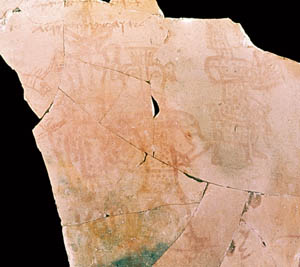Category:Asherah (subject)
Asherah was a goddess of the Canaanite pantheon.
YHWH and Asherah
Between the 10th century BC and the beginning of their exile in 586 BC, polytheism was normal throughout Israel; it was only after the exile that worship of Yahweh alone became established.
The relationship between Asherah and Israel is a complicated one. Jeroboam and Rehoboam fostered Asherah worship (1 Kings 14:15, 23). Worship of Asherah was highly encouraged by Jezebel, with the presence of 400 prophets who held a place in the court of her husband King Ahab (1 Kings 18:19). Worship of Asherah is given as a reason for deportation (2 Kings 17:10,16). Attempts to eradicate the worship were made by Asa, Josiah, Jehoshaphat, Hezekiah and Gideon (Exodus 34:13-14; Deuteronomy 7:5; Judges 6:25-30; 1 Kings 15:13/2 Chronicles 15:16; 2 Kings 23:4,7/2 Chronicles 34:3,7; 2 Kings 21:7/2 Chronicles 33:3,19; 2 Chronicles 19:3; 2 Kings 18:4). However, devotion to the cult symbol remained (Isaiah 27:9; Jeremiah 17:1; Micah 5:14). It is particularly interesting that objections to Asherah are found mostly in Deuteronomistic literature, rather than in the prophets. In both cases, the authors are much more concerned about the worship of Baal rather than Asherah.
It was common in the ancient world to believe that gods married and even bore children. This popular connection between Yahweh and Asherah, and the eventual purging of Asherah from the Israelite cult, is likely a reflection of the emergence of monotheism from the Israelites’ previous polytheistic worldview.
Inscription on a Pithos from Kuntillet ‘Ajrud (8th cent. BCE)
Located in the Sinai desert about 10 miles west of the ancient Gaza Road (Darb Ghazza, in Arabic) as it passes through Bedouin territory separating the Negev from Egypt, Kuntillet ‘Ajrud is remote and isolated from any other settlement. In 1975, Tel Aviv University archaeologist Ze’ev Meshel with some volunteers and a few colleagues as staff, decided to excavate at the site.
The finds from Kuntillet ‘Ajrud were fantastic. The zingers were two large pithoi, or storage jars, that weighed about 30 pounds each. The now-reconstructed pithoi are painted with deities, humans, animals and symbols, and feature a number of inscriptions, including three that refer to YHWH and his wife Asherah.
“I bless you by YHWH and his Asherah” is written across the top of this eighth-century B.C. drawing on a ceramic pithos, or storage jar, from Kuntillet ‘Ajrud in the eastern Sinai. Scholars have theorized that these figures resembling the Egyptian god Bes (who is the one depicted on the left) are in fact a drawing of YHWH and his consort. Two other similar inscriptions have been found in the site of this ancient sanctuary: "YHWH of Teman and his Asherah", and "Blessed be Uriyahu by YHWH for from his enemies by his (YHWH's) Asherah he (YHWH) has saved him ... "
Bibliography
- Judith M. Hadley, The Cult of Asherah in Ancient Israel and Judah: Evidence for a Hebrew Goddess, University of Cambridge Oriental Publications (Cambridge: Cambridge University Press, 2000).
- C. Frevel, Aschera und der Ausschliesslichkeitsanspruch YHWHs, Bonner biblische Beitrage (Weinheim: Belz Athenaum Verlag, 1995).
- William Dever, Did God Have a Wife? Archaeology and Folk Religion in Ancient Israel (Grand Rapids: Eerdmans, 2005), pp. 176–251.
Media in category "Asherah (subject)"
This category contains only the following file.
- 1990 Smith.jpg 338 × 500; 40 KB


